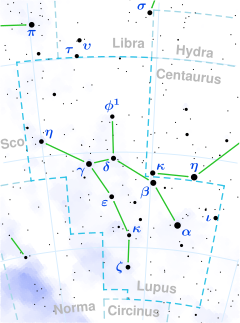
| |
| Observation data Epoch J2000.0 Equinox J2000.0 | |
|---|---|
| Constellation | Lupus |
| Right ascension | 15 22 40.86826 |
| Declination | –44° 41′ 22.6146″ |
| Apparent magnitude (V) | 3.41 |
| Characteristics | |
| Spectral type | B2 IV-V |
| U−B color index | –0.778 |
| B−V color index | –0.195 |
| Astrometry | |
| Radial velocity (Rv) | +7.9 km/s |
| Proper motion (μ) | RA: −22.86 mas/yr Dec.: −18.87 mas/yr |
| Parallax (π) | 6.37 ± 0.70 mas |
| Distance | approx. 510 ly (approx. 160 pc) |
| Absolute magnitude (MV) | −2.55 |
| Orbit | |
| Primary | Aa |
| Companion | Ab |
| Period (P) | 4.55970 d |
| Semi-major axis (a) | 29.2 R☉ |
| Eccentricity (e) | 0.277 |
| Inclination (i) | 20.5° |
| Periastron epoch (T) | 2452790.33 |
| Argument of periastron (ω) (secondary) | 17° |
| Semi-amplitude (K1) (primary) | 53.8 km/s |
| Semi-amplitude (K2) (secondary) | 64.7 km/s |
| Details | |
| ε Lup Aa | |
| Mass | 13.24 M☉ |
| Radius | 4.7 R☉ |
| Luminosity (bolometric) | 3,200 L☉ |
| Surface gravity (log g) | 3.89 ± 0.17 cgs |
| Temperature | 19,275 ± 1800 K |
| Rotational velocity (v sin i) | 133 km/s |
| ε Lup Ab | |
| Radius | 3.8 R☉ |
| Other designations | |
| ε Lup, CPD−44° 7342, HD 136504, HIP 75264, HR 5708, SAO 225712 . | |
| Database references | |
| SIMBAD | data |
Epsilon Lupi, Latinized from ε Lup, is a multiple star system in the southern constellation of Lupus. At an apparent visual magnitude of 3.41, Epsilon Lupi can be readily viewed from the southern hemisphere with sufficiently dark skies. It is the fifth-brightest star or star system in the constellation. Parallax measurements give a distance to this system of roughly 510 light-years (160 parsecs).
This system is what astronomers term a double-lined spectroscopic binary. When the spectrum is examined, the absorption line features of both stars can be viewed. As a result of the Doppler effect, these lines shift back and forth in frequency as the two stars orbit around each other. This allows some of their orbital elements to be deduced, even though the individual stars have not been resolved with a telescope. The pair share a close, elliptical orbit with a period of 4.55970 days. The orbital eccentricity is 0.277, which means that at the separation at closest approach, or periapsis, is only 57% of the distance at their greatest separation, or apoapsis. There is a third, more distant companion at an angular separation of around 1 arcsecond that may be orbiting the pair with a period of about 64 years.
The pair that share the close orbit, Epsilon Lupi Aa and Epsilon Lupi Ab, have estimated masses of 13.24 and 11.46 times the mass of the Sun, respectively. The more distant component, Epsilon Lupi B, has a mass of about 7.64 times the Sun. The combined stellar classification of the system is B2 IV-V, while the individual components may have spectral classes of B3 IV, B3 V, and A5 V, in order of decreasing mass. The inner A-a pair appear to have their rate of spin synchronized with their orbit, so that the same face of each star always faces its partner. The secondary, Epsilon Lupi a, shows regular variation in luminosity of the type that occurs with Beta Cephei variables, at a periodicity of 10.36 cycles per day.
This star system is a probable member of the Scorpius–Centaurus association, a moving group of stars that originated together and share a similar trajectory through space.
References
- ^ van Leeuwen, F. (November 2007), "Validation of the new Hipparcos reduction", Astronomy and Astrophysics, 474 (2): 653–664, arXiv:0708.1752, Bibcode:2007A&A...474..653V, doi:10.1051/0004-6361:20078357, S2CID 18759600
- ^ Gutierrez-Moreno, Adelina; Moreno, Hugo (June 1968), "A photometric investigation of the Scorpio-Centaurus association", Astrophysical Journal Supplement, 15: 459, Bibcode:1968ApJS...15..459G, doi:10.1086/190168
- ^ Uytterhoeven, K.; et al. (September 2005), "The orbit of the close spectroscopic binary epsilon Lup and the intrinsic variability of its early B-type components", Astronomy and Astrophysics, 440 (1): 249–260, arXiv:astro-ph/0507376, Bibcode:2005A&A...440..249U, doi:10.1051/0004-6361:20053009, S2CID 16644667
- Evans, D. S. (June 20–24, 1966). "The Revision of the General Catalogue of Radial Velocities". In Batten, Alan Henry; Heard, John Frederick (eds.). Determination of Radial Velocities and their Applications, Proceedings from IAU Symposium no. 30. Determination of Radial Velocities and Their Applications. Vol. 30. University of Toronto: International Astronomical Union. p. 57. Bibcode:1967IAUS...30...57E.
- Anderson, E.; Francis, Ch. (2012), "XHIP: An extended hipparcos compilation", Astronomy Letters, 38 (5): 331, arXiv:1108.4971, Bibcode:2012AstL...38..331A, doi:10.1134/S1063773712050015, S2CID 119257644.
- "gam Sgr -- Variable Star", SIMBAD, Centre de Données astronomiques de Strasbourg, retrieved 2012-01-08
- The ratio of the periapsis (rp) to the apoapsis (ra) is given by:
| Constellation of Lupus | |||||||||||||
|---|---|---|---|---|---|---|---|---|---|---|---|---|---|
| Stars |
| ||||||||||||
| |||||||||||||
| |||||||||||||
| |||||||||||||
| |||||||||||||
